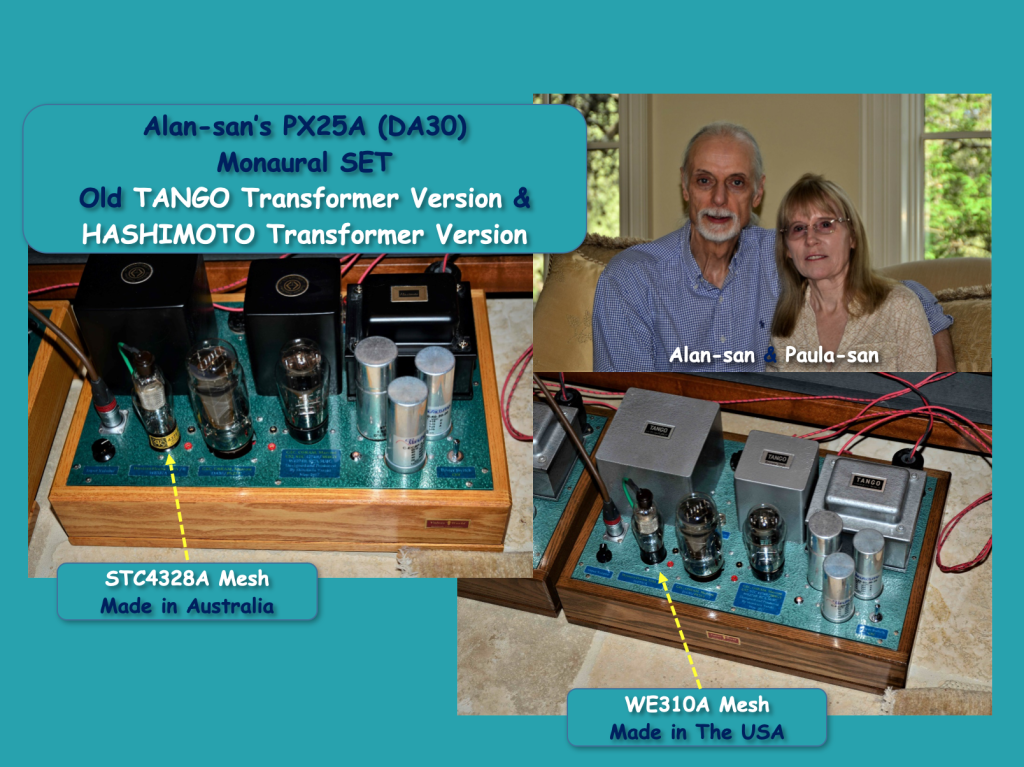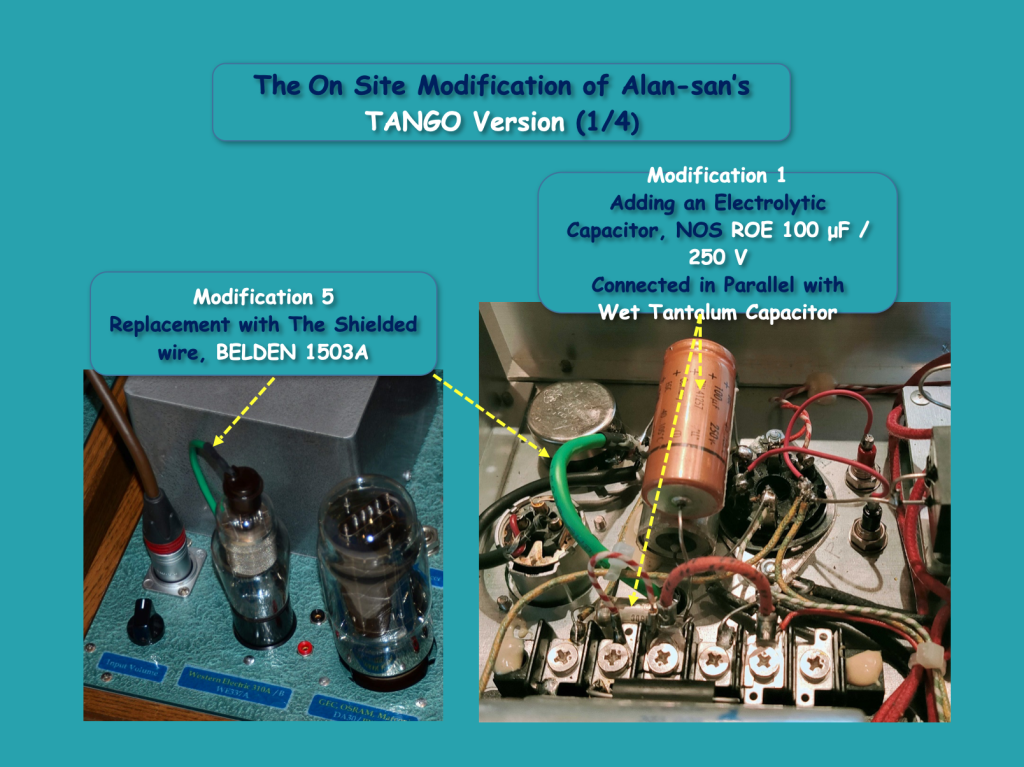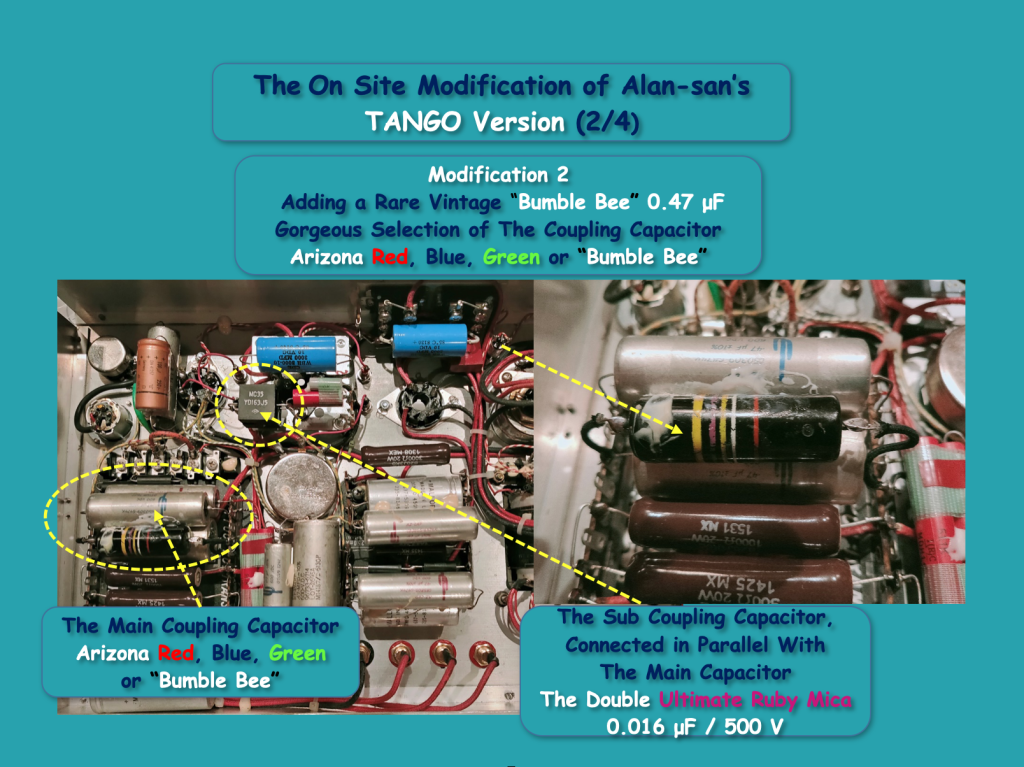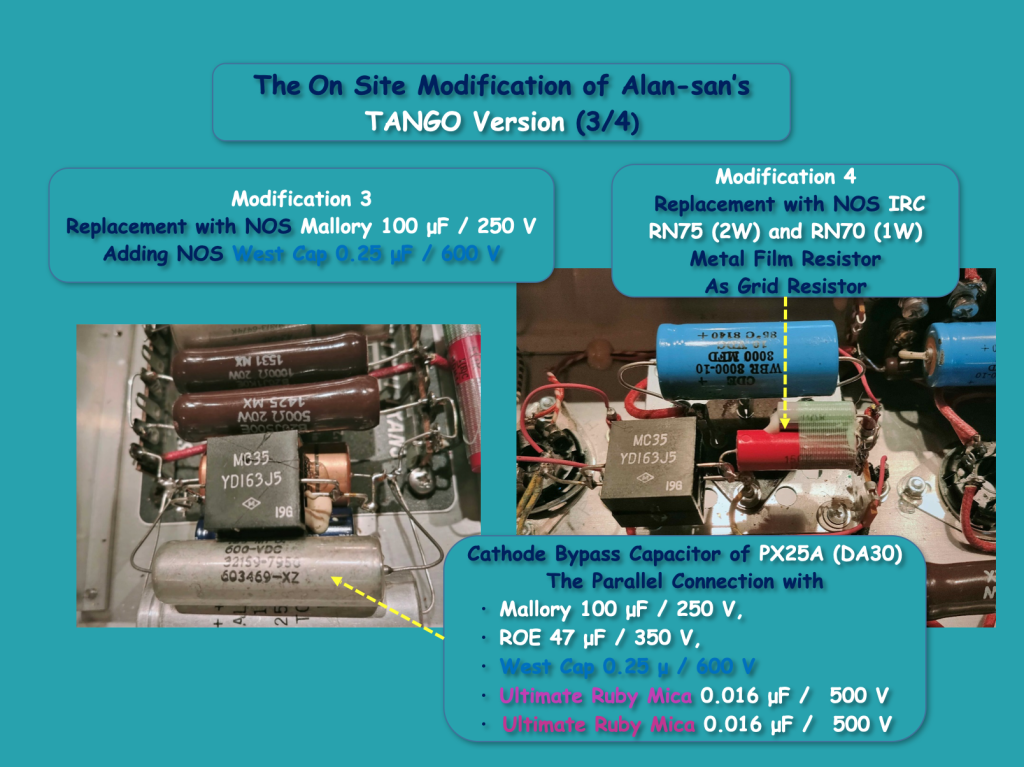On Site Version Upgrade of Old Tango Version and Hashimoto Version at Alan-san’s House
Well, I really wanted Alan-san to experience this version upgrade of strengthening the bypass capacitor, especially in the first stage.
Alan-san, my very close friend, had already obtained the Hashimoto transformer version at the end of 2017, and the old Tango transformer version two years later, and has been enjoying the music in combination with his Altec Corona loudspeakers.
So, I made this suggestion to Alan-san. It was May 23rd 2022: “Hello Alan-san, Even though I received your kind words, sorry for my late reply! I'm so appreciative! You will see the latest Ryszard-san's system on his friend's YouTube" (below)"
"Today, I must confess about the remarkable and very recent sound improvement on Ryszard-san's DA30 mono SET."
"It is the strengthening or the refinement of the bypass capacitors of mainly the driver tube, WE310A, 337A, 328A, STC4310A or 4328A."
"You can see how great and amazing this sound quality improvement is for me by reading my description below."
"Yes, it would truly be the one of most valuable "Capacitor Adventures" I have ever experienced. Therefore, I would definitely recommend this version upgrade for your PX25A mono SET."
I wanted to visit Alan-san's house to do an on-site service for the modification. Fortunately, the corona epidemic had subsided, and Japan's restrictions significantly relaxed.
If Alan-san agreed with this idea, I would like to first meet with Honda-san in California before visiting Alan-san. The modification work was not so complicated, so I would be able to complete it within a few hours. So I shipped the parts to Alan-san.
Fortunately and thankfully, Alan-san willingly accepted my proposal, and I had the rare chances to cross over the Pacific Ocean and to stay at Alan-san's house for three nights and completed the full version upgrade of each monaural SET.
Anyways, it's been more than 3 years after Alan-san kept at hand these SETs, and I wanted to try new improvements, so the contents of this full version upgrade had included quite a wide variety of modification. Let's take a look at the contents of the version upgrade of Tango version as an example.
Modification 1; Adding an electrolytic capacitor, Roe 100 μF / 250 V to existing wet tantalum capacitor as the cathode bypass capacitor of the first tube, WE310A. It would be the main object of this version upgrade and far spacious sound stage and richer low range will be expected.
Modification 5; Replacement with the shielded wire, Belden 1503A for the grid cap of the WE310A from the existing standard single-wire lead. It should effectively prevent induced noise caused by leakage flux from power transformer and realize a quieter amplifier. Of course, there was no deterioration in sound quality, which could be a disadvantage in replacing it with a shielded wire.
Modification 2; Adding a rare vintage “Bumble Bee”, 0.47 μF / 400 V as a main coupling capacitor. And so Alan-san will be able to select and fully enjoy the fame of good old day’s American sound. And the double Ultimate Ruby Mica, 0.016 μF / 500 V, connected in parallel will surely add the charm of modern high fidelity taste to this Bumble Bee. By the way, this Bumble Bee was once removed from Alan-san's Model 7 five years ago but luckily, this Bumble Bee, 0.47 μF only kept in a mint condition throughout far more than a half century.
Modification 3; Replacement with Mallory 100 μF / 250 V from existing Nichicon 100 μF / 250 V, because of the lowest ESR of this Mallory. And adding West Cap 0.25 μF / 600 V for lowering ESR of mid-to-high frequencies of the bypass capacitor for PX25A (DA30). And this modification will bring out the full audio potential of the truly excellent GEC PX25A.
Modification 4; Replacement with NOS IRC RN75 (2W) and RN70 (1W) metal film resistor from existing Allen Bradley solid carbon resistor as grid resistor of PX25A (DA30). And the lower limit of the noise level of the amplifier would be further lowered by these splendid IRC metal film resistors, and Alan-san will be able to expect a quieter and clearer sound than before.
Modification 6; Replacement with the higher performance and more desirable sounding capacitors and resistors for improving the sound quality of P-K feedback from existing parts. I only looked for another level of smoother and more refined sound with the P-K feedback, which has been practically the default setting. The CDE 940C TYPE that I had used so far is a very high-performance PP (metalized polypropylene) capacitor with no problems in terms of characteristics. But when I replaced it with West Cap NOS hermetic seal capacitor, it transforms into a very organic sound. In addition, since the signal current flows into the resistor that determines the amount of feedback, a resistor with a large wattage and a minimal noise level is required. For that reason, I made sure to solder two large IRC RN80, 3W types in series connection.
Alan-san and Paula-san picked me up at the airport in the early afternoon, and I started to make the modification immediately after arrival.
Through the dinner, the modification of the Tango version continued, and it was already past 10:00 at night when it was completed the work. Unexpectedly, I needed a lot of time. After checking the voltages, I started to check the actual operation by connecting his beloved loudspeakers, the Altec Coronas, while Alan-san was watching anxiously.
Of course, it was a very tense moment for me. This is because the success or the failure of visiting Alan-san's house after crossing the ocean all the way truly depended on this moment.
But, at only the first listen, my feelings, not my reason shouted at me that this version upgrade was a success.
The next morning I overslept a little because I felt so relieved about the successful version upgrade. After a morning walk with Alan-san in the lush greenery, I immediately turned on the Tango version and we started to a hearing comparison between Non-Feedback and P-K Feedback.
The sound playback with the combination of WE310A mesh, GEC PX25A, Marconi U52, and the used FW-50-5S, TANGO output transformer, wound up half a century ago, were both attractive.
In a word, Non-Feedback sound was characterized by a very powerful sound that stretches forward, and on the other hand, P-K Feedback was filled with a silky and smooth tone. Even so, I couldn't help but feel the extremely flat energy balance of the Tango FW-50-5S, made in early 70’s, from the low range to the high range.
I felt that the sound quality of this transformer without specific sound character brought out the introspective tone that only WE310A mesh shield has, which is the earliest version made in 1940’s, and P-K Feedback mode with this WE310 mesh made me feel a sense of deep shadows, even more, it should be also one major aspect of music.
Fortunately, within the evening on this day, the modification of Hashimoto version was also successfully completed, and I confirmed the setting of P-K Feedback mode.
Then, I changed the heater voltage from default 10 V to 7.5 V to be able to listen the sound of STC4328A mesh, which was made in Australia as I wrote before.
It must have been the first time for Alan-san to experience the sound of this pentode driver tube. When I first listened to the playback with the Altec Coronas driven by the combination of the rarest NOS STC 4328A mesh and the latest Hashimoto H-30-5S output transformer, I was finally able to hear a truly “Real Sound” reproduction that was impeccable even from an audio reproduction standpoint.
I only felt, the sound was just powerful, purely transparent, and had a rich tone in contrast. I also felt that STC 4328A mesh's silky soft and delicate expression was equal to or better to the quality of WE310A mesh, which I have been familiar with for a long time.
Well, I would like to introduce you this topic with my unforgettable session. Early in the morning of the third day, when I was still in bed and searching for an exciting YouTube music video to enjoy with Alan-san.
I didn't know why, but the song that came to my mind was “Just a Gigolo” and the first thing I found was this YouTube video below. The piano at the begging was beautiful, the male vocal's voice and his phrasing were my favorite, and the backing chorus, saxophone, and trumpet played their roles perfectly.
So, before the session on the third day started, I told Alan-san to listen to this on my Android phone. As soon as this music started playing, Alan-san was so surprised and almost jumped, and he told me with a smile when he retired earlier than Paula-san, the people around him jokingly called him Gigolo.
Finally, he started swaying his body to the song. Actually, the recording was wonderful and well organized and after that, we enjoyed the playback at a volume higher than full. The brass that we listened to on the Altec Coronas was really powerful and impressive. I believe, it could only be said that this realistic and brilliant expression of the brass part can only be heard from the high-efficiency horn driver such as vintage Altec or JBL.
In any case, I managed to complete the version upgrade as I had planned, and I was able to experience the remarkable sound of the Altec Coronas plus the JBL 2405 super tweeter system.
What a happy time I had, as an Altec ardent believer for a long time.
Well, I just wanted to thank Paula-san and Alan-san for such a wonderful situation, and of course, the happiest three days.
That afternoon, I had the time to record Alan-san's own blues guitar performances on his several vintage 1930’s guitars, which were another of Alan-san's proud collections, with my digital recorder, TASCAM DR-100 MKⅡ.
It was completely outside my area of expertise, but I was struck by the extremely delicate, beautiful, and truly introspective performance. Once again, I was just thinking of Alan-san's humble, gentle and sincere personality with fully refined sense. Such sense is surely innate, and I believe it's just a gift from the Lord.
Now, what the readers of Jeff's Place would like to know how Alan-san and Paula-san, actually felt or feel now the differences or the improvements in sound quality, before and after the version upgrade.
Moreover, about 10 months have passed since that point, and almost all parts must have been burning in well, and the smoothness of the sound might have gradually changed to a higher quality one.
As I wrote in the previous Part 5, all of the listening sessions at the time were only made by using “iPhone Adventure”, and after that, Alan-san must have enjoyed the sound of analog LPs with his splendid and well-used turntable systems, Shure Type Ⅲ cartridge body plus new JICO stylus, VN35MRBⅡ, and his beautiful Model 7, which has been modified twice in the past.
I myself had high hopes to hear Alan-san’s frank feelings and impressions. When the sound quality reaches this level, which is very close to a “Real Sound”, the usual audio review would be meaningless because our senses are only naturally immersed in music.
So, Alan-san's specialty literary expressions of his favorite music and sources must be able to express the essence of things. Of course, Paula-san’s perceptions would be also very valuable for me.
































